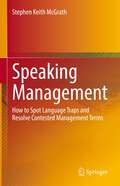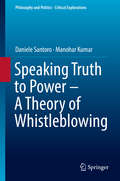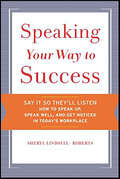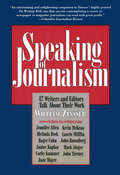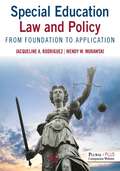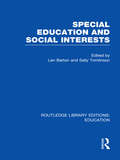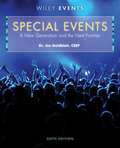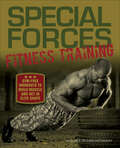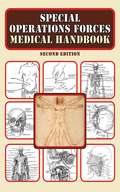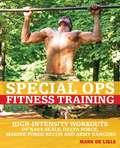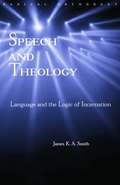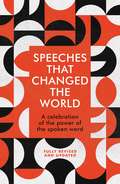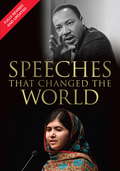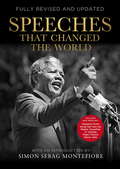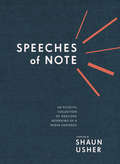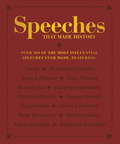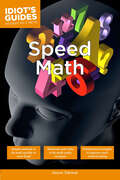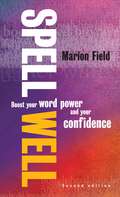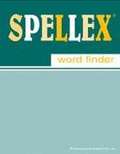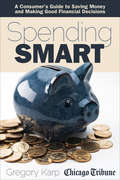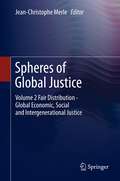- Table View
- List View
Speaking Management: How to Spot Language Traps and Resolve Contested Management Terms
by Stephen Keith McGrathThis book identifies ten linguistic traps in our everyday language usage and provides philosophical justification for a method of determining internally consistent definitions of groups of related terms that avoid all ten traps. Various examples and applications of this method are given throughout. The book demonstrates how the seemingly straightforward matter of our understandings of the meaning of words can have major implications for the exercise of power. This book illustrates how this insight originated from management research into project governance that found lack of agreement on the definition of that term, as well as on many other important management terms. To resolve this, the impacts of evolution, philosophy and linguistics upon our everyday language usage were investigated. The research documented in this book found that the human tool called language works well for describing physical objects but has difficulty producing a common understanding of the meaning of concepts - a problem not restricted to the management field. That field is simply a microcosm that exposes a much more widespread linguistic usage problem affecting our personal, religious and political lives; one that existed at the time of Plato and Aristotle and has laid hidden for millennia. This book includes a lexicon of 69 commonly used but confused or contested management terms, all developed by applying its definitional method. The terms include governance, power, ethics, leadership and their associated groups of terms. The book explores how disagreement can be resolved using these new clear definitions and extends this into an analysis of who ‘good’ ethics are good for. It also incorporates a section on “how to speak management and actually know what you are talking about”, written in the style of an ‘idiots guide’ or ‘guide for dummies’. This identifies common, everyday circumstances in which lack of agreed definitions cause avoidable confusion and provides the book’s focus on conflict dissolution rather than on conflict resolution.
Speaking Truth to Power - A Theory of Whistleblowing (Philosophy and Politics - Critical Explorations #6)
by Daniele Santoro Manohar KumarWhistleblowing is the public disclosure of information with the purpose of revealing wrongdoings and abuses of power that harm the public interest. This book presents a comprehensive theory of whistleblowing: it defines the concept, reconstructs its origins, discusses it within the current ethical debate, and elaborates a justification of unauthorized disclosures. Its normative proposal is based on three criteria of permissibility: the communicative constraints, the intent, and the public interest conditions. The book distinguishes between two forms of whistleblowing, civic and political, showing how they apply in the contexts of corruption and government secrecy. The book articulates a conception of public interest as a claim concerning the presumptive interest of the public. It argues that public interest is defined in opposition to corporate powers and its core content identified by the rights that are all-purposive for the distribution of social benefits. A crucial part of the proposal is dedicated to the impact of security policies and government secrecy on civil liberties. It argues that unrestrained secrecy limits the epistemic entitlement of citizens to know under which conditions their rights are limited by security policies and corporate interests. When citizens are denied the right to assess when these policies are prejudicial to their freedoms, whistleblowing represents a legitimate form of political agency that safeguards the fundamental rights of citizens against the threat of unrestrained secrecy by government power. Finally, the book contributes to shifting the attention of democratic theory from the procedures of consent formation to the mechanisms that guarantee the expression of dissent. It argues that whistleblowing is a distinctive form of civil dissent that contributes to the demands of institutional transparency in constitutional democracies and explores the idea that the way institutions are responsive to dissent determines the robustness of democracy, and ultimately, its legitimacy. What place dissenters have within a society, whether they enjoy personal safety, legal protection, and safe channels for their disclosure, are hallmarks of a good democracy, and of its sense of justice.
Speaking Your Way to Success
by Sheryl Lindsell-RobertsIn Speaking Your Way to Success, Sheryl Lindsell-Roberts draws on years of experience as a business communications expert to deliver straightforward guidelines for professionals on how to speak powerfully and effectively. Whether talking in front of a large group or engaging in a one-to-one conversation, this book will help anyone to speak up, speak well, and get noticed. Chapters include: -- Making Introductions -- Developing Listening Skills -- Using Politically Neutral Language -- Interviewing and Being Interviewed -- Speaking in Public -- Communicating Cross-Culturally -- Harnessing the Power of Today&’s Multigenerational Workforce In her signature no-nonsense style, Lindsell-Roberts shows speakers how to pay attention to their audience, support their words with body language, interject stories the audience will relate to and enjoy, encourage audience interaction, and more. This book is packed with specific suggestions that can be applied immediately on topics such as giving and receiving compliments, keeping a conversation going, asking for a raise, and cold calling. There are strategies for introducing yourself when you don&’t know anyone at an event, techniques for initiating conversation, and a checklist for rating your listening skills. Lindsell-Roberts also has a proven, no-fail attack plan for how to work a room. Stop lurking quietly in the shadows and start speaking your way to success!
Speaking of Journalism
by William ZinsserVeteran journalist and writing teacher William Zinsser, whose books on writing have sold more than 700,000 copies, presents 11 of his most successful students discussing what it is like to work as a journalist in the 1990s.
Special Education Law and Policy: From Foundation To Application
by Wendy W. Murawski Jacqueline A. RodriguezUnderstanding the relationship between law, advocacy, and Special Education is crucial for those who educate and advocate on behalf of students with disabilities. Special Education Law and Policy: From Foundation to Application provides a framework for understanding and implementing the law as it applies to students with disabilities and their families. Dr. Rodriguez and Dr. Murawski crafted a textbook that distills complex legal concepts into a digestible format to ensure readers understand their roles as teachers, counselors, administrators, and advocates. Their clear and accessible style of writing is intended for students and practitioners and offers case law and real-world examples to highlight the effective application of both law and policy. With contributions from experienced educators and legal professionals, readers will gather the foundational knowledge they need to support students, families, and schools. This is the text that every administrator, teacher, and advocate will want at their fingertips!
Special Education and Social Interests (Routledge Library Editions: Education)
by Len Barton Sally TomlinsonUntil this book was published, most writing on special education was about specific disabilities and how to cope with them. This book, however, considers the broader context, looking at many problems for the wider system that have arisen through integration of special education within it. The book is international and comparative in its focus and includes much North American material and work by North American researchers.
Special Events: A New Generation and the Next Frontier
by Joe GoldblattIntended for students aspiring to be event planners or event leaders, this textbook on the global celebration industry takes a Scottish and global perspective, with many examples drawn from Scotland as well as other parts of the world. The text features case discussion exercises and activities emphasizing corporate social responsibility, global connections, and technology, and offers profiles of professionals around the world, plus color and b&w photos. After an introduction to the theory of event leadership, coverage encompasses event administration and coordination, marketing, legal and ethical issues, and risk management, with a final section on technology for professional development. The text includes a list of books, websites, organizations, and suppliers related to green approaches in event planning. This sixth edition emphasizes how events use rituals and ceremonies to promote continuity and stability in human communities, and contains new chapters on environmental sustainability and corporate social responsibility. There are also new case studies, including the 2008 Summer Olympics and the Homecoming Scotland 2009 celebrations. Goldblatt is affiliated with Queen Margaret University. Annotation ©2011 Book News, Inc. , Portland, OR (booknews. com)
Special Forces Fitness Training: Gym-Free Workouts to Build Muscle and Get in Elite Shape
by Augusta DeJuan HathawayReshape your body with the intense Navy SEAL and Army Ranger workout program created by a United States military strength and conditioning coordinator. Do you have what it takes to be a special ops soldier? To be a member of the military&’s most elite units—Navy SEALs, Marine Force Recon, Army Rangers or Green Berets—you must be in phenomenal condition, able to endure high levels of physical and mental stress. In this book, author Augusta DeJuan Hathaway shows how to get in the best shape of your life using the program he developed as a strength and conditioning specialist for the U.S. military special forces. Be prepared to go all in or go home! Special Forces Fitness Training presents gym-free regimens that challenge you to train like a bad-ass. With the thirty hardcore workouts in this book you will: • Develop massive strength • Increase speed & agility • Extend fatigue threshold • Improve balance & flexibility • Boost mental fortitude
Special Operations Forces Medical Handbook
by Department of DefenseThe newest edition of the Special Operations Forces Medical Handbook is perfect and practical for both soldiers and civilians. Nearly 140 comprehensive illustrations show the proper techniques for medical care, from basic first-aid and orthopedics to instructions for emergency war surgery and even veterinary medicine. Questions are listed so that the medic can obtain an accurate patient history and perform a complete physical examination. Diagnoses are made easier with information on the distinctive features of each illness. This straightforward manual is sure to assist any reader faced with a medical issue or emergency.
Special Ops Fitness Training: High-Intensity Workouts of Navy Seals, Delta Force, Marine Force Recon and Army Rangers
by Mark De LisleTest yourself against the world&’s most elite fighting forces with this fitness program modeled after the special operations training programs. In Special Ops Fitness Training, ex-Navy SEAL Mark De Lisle brings together the most rigorous conditioning techniques from America&’s top military programs in order to create the ultimate workout. Packed with mind-challenging, body- strengthening tasks that test the mettle of any athlete, this phenomenal conditioning manual presents the best of the best as it shows you how to reach the highest levels of fitness. Every aspect of training is incorporated into the program, including warm-ups, stretching, upper body, lower body, cardio, running, swimming, goal-setting, and motivation. The author has trained thousands of people and witnessed time and again the amazing results achieved by these unique techniques. He teaches readers what it takes to rise to the occasion when nothing less than total commitment will do. Drawn from the actual programs used by America&’s special operation forces: •Navy SEALs •Army Rangers •Delta Force •Marine Force Recon
Speech and Theology: Language and the Logic of Incarnation (Routledge Radical Orthodoxy)
by James K.A. SmithGod is infinite, but language finite; thus speech would seem to condemn Him to finitude. In speaking of God, would the theologian violate divine transcendence by reducing God to immanence, or choose, rather, to remain silent? At stake in this argument is a core problem of the conditions of divine revelation. How, in terms of language and the limitations of human understanding, can transcendence ever be made known? Does its very appearance not undermine its transcendence, its condition of unknowability?Speech and Theology posits that the paradigm for the encounter between the material and the divine, or the immanent and transcendent, is found in the Incarnation: God's voluntary self-immersion in the human world as an expression of His love for His creation. By this key act of grace, hinged upon Christs condescension to human finitude, philosophy acquires the means not simply to speak of perfection, which is to speak theologically, but to bridge the gap between word and thing in general sense.
Speeches That Changed the World
by QuercusFrom calls to arms to demands for peace, and from cries of freedom to words of inspiration, this stirring anthology captures the voices of prophets and politicians, rebels and tyrants, soldiers and statesman, placing them in historical context. With over a million copies already sold, this completely revised and updated pocket edition includes speeches by those that have truly shaped the modern world: from Greta Thunberg to Donald Trump, and from Nadia Murad to Oprah Winfrey. A biography of each speaker reveals how they came to stand at the crossroads of history, and each speech is accompanied by an introduction explaining its historical context and how it influenced the momentous events of the day - as well as those that followed. By turns moving and thought-provoking, this new edition reveals a modern world in which freedom of speech remains a powerful agent of change - and gives unique perspectives on key turning points in history. Contents include: Nelson Mandela, Barack Obama, Martin Luther King, Jr, Queen Elizabeth I, Oliver Cromwell, George Washington, Napoleon Bonaparte, Abraham Lincoln, Emmeline Pankhurst, Mohandas K. Gandhi, Adolf Hitler, Joseph Stalin, Franklin D. Roosevelt, Charles de Gaulle, George S. Patton, Jr, Malcolm X, Vaclav Havel, Mikhail Gorbachev, Indira Gandhi and Winston Churchill to name a few.
Speeches That Changed the World
by QuercusWith over a million copies already sold, this is the newly updated edition of the definitive collection of great speeches ancient and modern. From calls to arms to demands for peace, and from cries of freedom to words of inspiration, this stirring anthology captures the voices of prophets and politicians, rebels and tyrants, soldiers and statesman, placing them in historical context.This revised edition includes speeches that have shaped the modern world: from Aung San Suu Kyi on freedom to Al Gore on the environment and from Malala Yousafzai on the education of women to Pope Francis on peace. A biography of each speechmaker reveals how they came to stand at the crossroads of history, and each speech is accompanied by an introduction explaining its historical context and how it influenced the momentous events of the day - as well as those that followed.Moving and thought-provoking, this new edition will continue to inspire and enlighten readers, offering them a fascinating perspective on historical milestones through the power of the spoken word. Contents include: Nelson Mandela, Malala Yousafzai, Barack Obama, Pope Francis, Martin Luther King, Elizabeth I, Oliver Cromwell, George Washington, Napoleon Bonaparte, Abraham Lincoln, Emmeline Pankhurst, Mahatma Gandhi, Adolf Hitler, Joseph Stalin, Franklin D. Roosevelt, Charles de Gaulle, General George S. Patton, Mao Zedong, Malcolm X, Vaclav Havel, Mikhail Gorbachev, Indira Gandhi and Winston Churchill to name a few.
Speeches That Changed the World
by QuercusFrom calls to arms to demands for peace, and from cries of freedom to words of inspiration, this stirring anthology captures the voices of prophets and politicians, rebels and tyrants, soldiers and statesman, placing them in historical context. With over a million copies already sold, this revised and updated edition includes speeches that have shaped the modern world: from Aung San Suu Kyi on freedom to Al Gore on the environment and from Malala Yousafzai on the education of women to Pope Francis on peace. A biography of each speechmaker reveals how they came to stand at the crossroads of history, and each speech is accompanied by an introduction explaining its historical context and how it influenced the momentous events of the day - as well as those that followed. New speeches include Malala Yousafzai's speech to the UN Youth Assembly on access to education (2013), Vladimir Putin's address regarding the annexation of Crimea (2014), Xi Jinping's Communist Party General Secretary's speech in Beijing (2012), Pope Francis's First Easter 'Urbi et Orbi' Message (2013) and Al Gore's address to the UN Bali Climate Change Conference (2007). Moving and thought-provoking, this new edition will continue to inspire and enlighten readers, offering them a fascinating perspective on historical milestones through the power of the spoken word. Contents include: Nelson Mandela, Barack Obama, Martin Luther King, Elizabeth I, Oliver Cromwell, George Washington, Napoleon Bonaparte, Abraham Lincoln, Emmeline Pankhurst, Mahatma Gandhi, Adolf Hitler, Joseph Stalin, Franklin D. Roosevelt, Charles de Gaulle, General George S. Patton, Mao Zedong, Malcolm X, Vaclav Havel, Mikhail Gorbachev, Indira Gandhi and Winston Churchill to name a few.
Speeches That Changed the World
by QuercusFrom calls to arms to demands for peace, and from cries of freedom to words of inspiration, this stirring anthology captures the voices of prophets and politicians, rebels and tyrants, soldiers and statesman, placing them in historical context. With over a million copies already sold, this completely revised and updated pocket edition includes speeches by those that have truly shaped the modern world: from Greta Thunberg to Donald Trump, and from Nadia Murad to Oprah Winfrey. A biography of each speaker reveals how they came to stand at the crossroads of history, and each speech is accompanied by an introduction explaining its historical context and how it influenced the momentous events of the day - as well as those that followed. By turns moving and thought-provoking, this new edition reveals a modern world in which freedom of speech remains a powerful agent of change - and gives unique perspectives on key turning points in history. Contents include: Nelson Mandela, Barack Obama, Martin Luther King, Jr, Queen Elizabeth I, Oliver Cromwell, George Washington, Napoleon Bonaparte, Abraham Lincoln, Emmeline Pankhurst, Mohandas K. Gandhi, Adolf Hitler, Joseph Stalin, Franklin D. Roosevelt, Charles de Gaulle, George S. Patton, Jr, Malcolm X, Vaclav Havel, Mikhail Gorbachev, Indira Gandhi and Winston Churchill to name a few.
Speeches of Note: An Eclectic Collection of Orations Deserving of a Wider Audience
by Shaun UsherFrom the author of the New York Times bestseller Letters of Note comes a collection of 75 of history's most interesting, profound, and sometimes unknown speeches from a range of scintillating personalities such as Frederick Douglass, Justin Trudeau, Albert Einstein, Meghan Markle, Barbara Jordan, and Ursula K. Le Guin. This thoughtfully curated and richly illustrated collection celebrates oratory old and new, highlighting speeches we know and admire, while also shining a light on profound drafts that were never delivered or have until now been forgotten. From George Bernard Shaw's warm and rousing toast to Albert Einstein in 1930 and the commencement address affectionately given to graduates at Long Island University by Kermit the Frog, to the chilling public announcement (that was thankfully never made) by President Richard Nixon should Neil Armstrong and Buzz Aldrin become stranded on the moon, Speeches of Note honors the words and ideas of some of history’s most provocative and inspiring personages.
Speeches that Made History: Over 100 of the most influential speeches ever made
by BountyRead the ideas, musings and declarations from some of history's most poignant moments.Speeches that Made History contains a selection of quotes, off-the-cuff remarks, retorts and announcements from across the world and from a wealth of opinions and ideologies, accompanied by a short background note to put them into context. Covering speeches from as early as 73 BC through to the modern day, they provide a broad picture of the way the use of rhetoric has changed - from the lengthy, impassioned speeches of the pre-mass communications era to the three-minute address or even shorter soundbite common now. From Descartes to Karl Marx, Barack Obama to Gandhi, some words are easy for all to agree with - others not so easy - and some contain ideas repellant to almost everyone. Hopefully, all will provoke thought.Chapters include:Ancient HistoryLoveReligionSciencePatriotismPhilosophyHumanity & LibertySportPoliticsWarMiscellaneous
Speeches that Made History: Over 100 of the most influential speeches ever made
by Speeches That Made HistoryRead the ideas, musings and declarations from some of history's most poignant moments.
Speed Cleaning
by Jeff CampbellClean your entire house in 42 minutes with the Clean Team's unbeatable system that makes every move count.NOTE: This edition does not include illustrations.
Speed Math: Simple Methods to Do Math Quickly in One’s Head (Idiot's Guides)
by Gaurav TekriwalDo math more quickly and with more confidence — with less reliance on paper, apps, and calculators. For people who automatically run to the nearest calculator, Idiot's Guides: Speed Math teaches tips, tricks, and straightforward methods to doing math at a fast — and accurate — rate. Practice examples easily illustrate how even the most math-shy person can better perform calculations.
Spell Well, 2nd Edition: Boost Your Word Power And Your Confidence
by Marion FieldIt is true. A well-written letter is taken far more seriously than one using misspelt words. Research shows that people automatically assume you're more intelligent, and they'll take notice of you in a way they never did before. Now, with the help of this book you can discover the power of words for yourself. There are checklists and steps that ensure you'll soon be writing with much greater confidence.Contents: 1. Identifying different sounds; 2. Checking capital letters; 3. Forming plurals and changing verbs; 4. Using prefixes, suffixes and hyphens; 5. Sorting out the changes; 6. Avoiding common mistakes; 7. Using apostrophes and abbreviations; 8. Revising chapters 1-7; 9. Exploring the dictionary; 10. Discovering the thesaurus; 11. Enhancing your writing; 12. Looking at American spelling; 13. Exploring new words, jargon and slang.
Spell Well, 2nd Edition: Boost your word power and your confidence
by Marion FieldIt is true. A well-written letter is taken far more seriously than one using misspelt words. Research shows that people automatically assume you're more intelligent, and they'll take notice of you in a way they never did before. Now, with the help of this book you can discover the power of words for yourself. There are checklists and steps that ensure you'll soon be writing with much greater confidence.Contents: 1. Identifying different sounds; 2. Checking capital letters; 3. Forming plurals and changing verbs; 4. Using prefixes, suffixes and hyphens; 5. Sorting out the changes; 6. Avoiding common mistakes; 7. Using apostrophes and abbreviations; 8. Revising chapters 1-7; 9. Exploring the dictionary; 10. Discovering the thesaurus; 11. Enhancing your writing; 12. Looking at American spelling; 13. Exploring new words, jargon and slang.
Spellex: Word Finder
by George Moore R. Talbot G. Willard WoodruffReference book for verifying spellings of frequently used writing words. Lists 3,000 base words with other word forms--more than 10,000 words in all.
Spending Smart: A Consumer's Guide to Saving Money and Making Good Financial Decisions
by Gregory Karp Chicago TribuneA collection of the Chicago Tribune&’s weekly &“Spending Smart&” articles from the award-winning business journalist and NerdWallet&’s credit cards expert. Spending Smart is a compact but immensely helpful collection of columns penned by Gregory Karp. Offering tips for consumers across a wide variety of fields, including insurance, banking, cars, phones, homes, travel, and more, this book is a terrific primer for how to take better care of your money and find deals where others aren&’t even looking. The simple and sober advice from Karp has made him a newspaper mainstay for many years, as evidenced by this book&’s vast amount of straightforward tips. In breaking down the true worth of a deal or exposing hidden value, Spending Smart is a reader&’s go-to financial adviser while on the go. Perfect to pull up on smartphones, e-readers, and tablets, Karp&’s friendly tone and measured counsel can be accessed just about anywhere readers have financial questions. Praise for Gregory Karp &“Greg Karp has a clear roadmap to wealth that is yours for the taking. Follow his simple steps and you will take control of your financial future. Get FIT now!&” —Clark Howard, The Clark Howard radio show &“Greg Karp gets it and you will too. His research and tips will help you keep more of the money you earn.&” —Steve & Annette Economides, New York Times bestselling authors of America&’s Cheapest Family Gets You Right on the Money &“The author provides solid advice and solid writing on a topic that benefits from a fresh voice.&” —Liz Pulliam Weston, MSN Money columnist and author of Your Credit Score
Spheres of Global Justice: Volume 1 Global Challenges to Liberal Democracy. Political Participation, Minorities and Migrations; Volume 2 Fair Distribution - Global Economic, Social and Intergenerational Justice
by Jean-Christophe MerleSpheres of Global Justice analyzes six of the most important and controversial spheres of global justice, each concerning a specific global social good. These spheres are democratic participation, migrations, cultural minorities, economic justice, social justice, and intergenerational justice. Together they constitute two constellations dealt with, in this collection of essays by leading scholars, in two different volumes: Global Challenges to Liberal Democracy and Fair Distribution. These essays illustrate each of the spheres, delving into their differences, commonalities, collisions and interconnections. Unlike many writings on global justice, Spheres of Global Justice does not content itself with describing the painful and advantageous effects of the globalization process as being ipso facto a global injustice or a just global order. Rather, this multidisciplinary collection of essays, from a pluralist inspiration, combines empirical analysis with theoretical approaches and ethical principles, paying close attention to two aspects of the effects of the globalization process. These aspects are the causal relationships that lead to such effects and the kinds of obligations, or of normative relationships between global rights and correlative duties, that applies to each specific individual case. This volume illustrates how diverse global obligations are, and how they can be, grounded in diverse relationships (identity, ability to provide help, causal responsibility, past injustices, protection of agency and promotion of independence, etc.). These essays also demonstrate that an ethical global approach has not only international or transnational, but also domestic, local and interpersonal dimensions.
